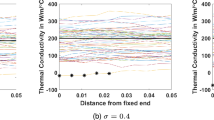Abstract
It is hard to solve ill-posed problems, as calculated temperatures are very sensitive to errors made while calculating “measured” temperatures or performing real-time measurements. The errors can create temperature oscillation, which can be the cause of an unstable solution. In order to overcome such difficulties, a variety of techniques have been proposed in literature, including regularization, future time steps and smoothing digital filters. In this paper, the Tikhonov regularization is applied to stabilize the solution of the inverse heat conduction problem. The impact on the inverse solution stability and accuracy is demonstrated.
Similar content being viewed by others
Abbreviations
- c :
-
specific heat, J/(kgK)
- k :
-
thermal conductivity, W/(mK)
- t :
-
time, s
- T :
-
temperature, °C or K
- q :
-
heat flux, W/m2
References
Rup, K, Duda, P, Danys, L, 2002., Determination of heat transfer coefficients on the surfaces of plastic tubes, Journal of Heat and Mass Transfer, 39, pp. 89–95.
Bourquin, F, and Nassiopoulos, A, 2011, Inverse reconstruction of initial and boundary conditions of a heat transfer problem with accurate final state, Int. J. of Heat and Mass Transfer, 54, pp. 3749–3760.
Duda, P, 2016, A general method for solving transient multidimensional inverse heat transfer problems, Int. J. of Heat and Mass Transfer, 93, pp. 665–673.
Taler, J., Duda, P., 2006. Solving Direct and Inverse Heat Conduction Problems, Springer, Berlin-Heidelberg.
Monde, M, Kosaka, M, and Mitsutake, Y, 2010, Simple measurement of thermal diffusivity and thermal conductivity using inverse solution for one-dimensional heat conduction, Int. J. of Heat and Mass Transfer, 53, pp. 5343–5349.
Tian, N, Sun, J, Xu W, and Lai, C-H, 2011, Estimation of unknown heat source function in inverse heat conduction problems using quantum-behaved particle swarm optimization, Int. J. of Heat and Mass Transfer, 54, pp. 4110–4116.
Zill, D. G, 1990, Differential Equations with Boundary- Value Problems. Prindle, Weber & Schmidt, Boston.
Tikhonov, A, 1965, On certain problems of linear algebra and a stable method of their solutions, (in Russian) Dokl. AN SSSR 163/3, pp. 591–594.
J. Taler, S. Grądziel, An Overdetermined Two-dimensional Transient Inverse Heat Conduction Problem, Forschung im Ingenieurwesen 65 (1999), 98–106, Springer-Verlag 1999.
Author information
Authors and Affiliations
Rights and permissions
About this article
Cite this article
Duda, P. Solution of inverse heat conduction problem using the Tikhonov regularization method. J. Therm. Sci. 26, 60–65 (2017). https://doi.org/10.1007/s11630-017-0910-2
Received:
Published:
Issue Date:
DOI: https://doi.org/10.1007/s11630-017-0910-2




